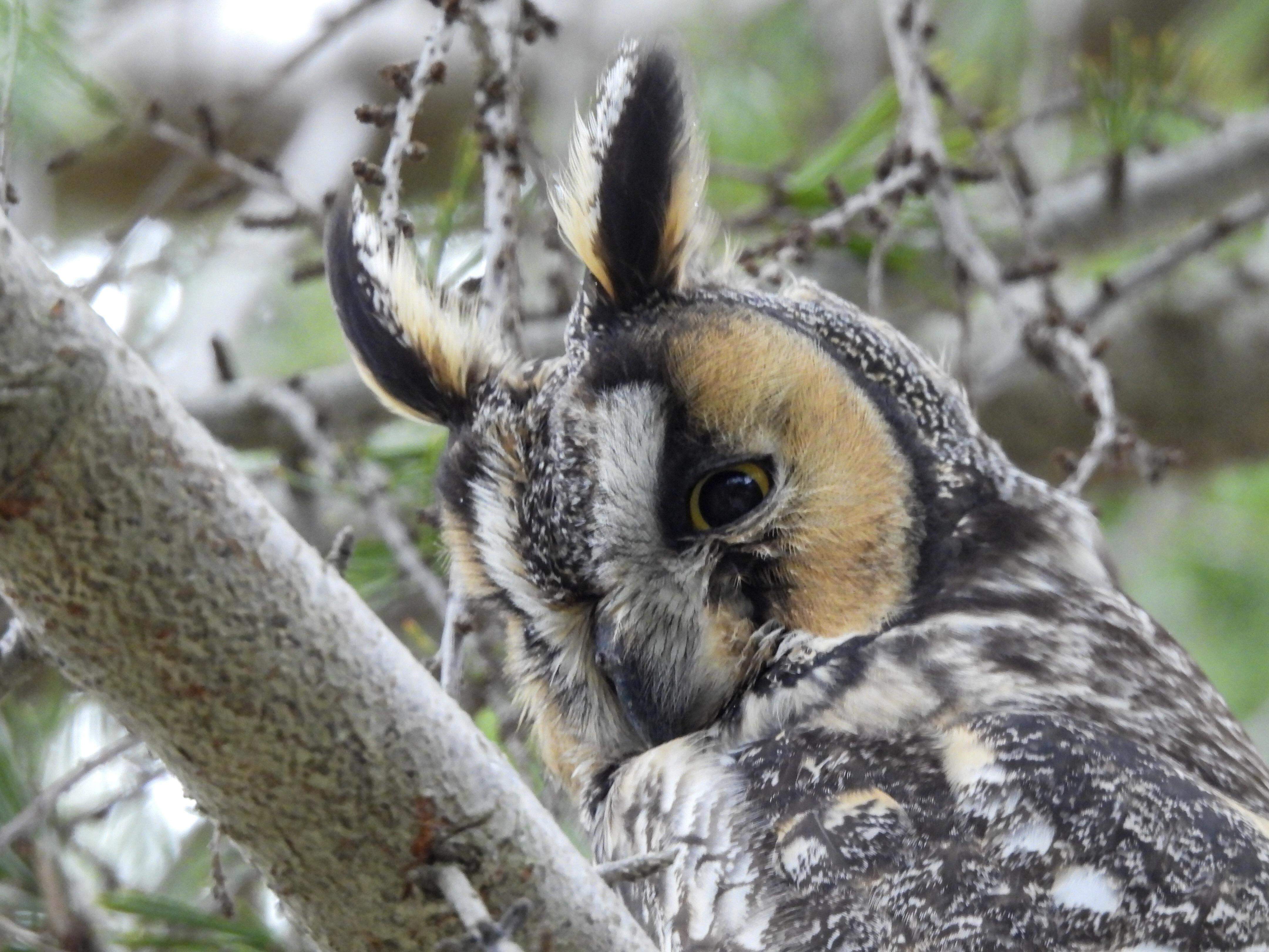Tigers are generally crepuscular which means they’re most active around dawn or dusk, when the sun is very low in the sky. Their orange fur does not stand out so well when everything looks orange under the golden light of dawn.
The green image of the tiger is terrifying. You wouldn’t see it until it’s eyes or teeth were baring down on you in a lush green forest. Thankfully humans weren’t it’s main prey and therefore it likely evolved to appear orange instead…
Umm, I’ve met tigers.
You need to explain to them that we’re not prey, but they haven’t figured it out yet.
fish are friends not food.
I think the key word is “main”.
I’m colorblind and the images are nearly identical. Good thing I’m not in tiger habitats very often.
Same. Didn’t even realise they were different images until after I read the text.
Those are different pictures?! Damn red-green colorblindness, gonna get me eaten by tigers
Almost like our eyes evolved to give danger its own colour.
Do tigers themselves see themselves as orange, or are they genuinely surprised when humans easily spot them hiding in the grass?
My cats are surprised both by me seeing them sitting on an empty floor, and by other cats who they didn’t see sitting on the floor.
So I can only conclude the answer is semi-perpetual amazement.
They do not, like almost all mammals they are dichromatic! It’s mostly us and some primates that can see in three wavelengths. Although interestingly enough, fish and birds can see in four wavelengths. Makes me wonder if that contributed to smaller cats being mostly gray and black, to just reduce as much light as possible?
Would not green be the obvious route then?
AFAIK green is more expensive to produce. Plants use it since it’s good at absorbing sunlight, but what’s the advantage to a tiger, if their prey can’t tell the difference?
Do the tigers know they are orange?
No, they too are dichromats
Probably not, the same way humans don’t know we are striped.
Ist is possible to make the own pattern visible? Like with special Cameras and Light?
Do humans know tigers are green?
Asking the real questions
Desperately need me a community just for tiger facts like this and pictures of tigers. Greatest of the Big Cats
Feel free to open !bigcats or !tiger I’ll be your first follower.
I wish lol. I don’t have enough time to manage a community though. if someone else made one though i’d follow it instantly
I vaguely remember someone mentioning a community to give your community ideas to who may want to implement it… I forgot the name.
Thank you for subscribing to Big Cat Facts
Is that why cats can be so ginger and still good hunters? My orange stands out so much in the garden, but maybe to dichromatic mice he’s super stealthy?
Elsewhere in the thread, someone said non-primate mammals (like mice) are dichromic (can’t see orange), but birds are quadchromic (see even more colors than trichromics like primates). Is your cat only a good mouse-hunter, and comparatively a bad bird-hunter?
He is! 95% mice, very occasional birds. I had attributed that to birds other advantages (mostly being able to harass him by flying at him but not low enough he can reach) but perhaps it’s also the colour!
Accidentally beautiful
this sounds dumb. if that was the reason then why arent they just green so that theyre camoflaged to EVERY animal and not just those with bad eyes
Mammals don’t come in green. We have 2 colours available to us, in different amounts: eumelanin, which is dark brown to black, and pheomelanin, which is yellow/red. We can mix those up in any way, or none (for white), but it’ll never be green.
Now, many other animals don’t have green either, peacock feathers for example, have brown pigment, but they have a structure that makes it look green and blue from wave interference.
Unfortunately, you can’t really do that with fur, since you need to look at fur from all directions, not just the front.
So, mammals don’t get green fur.
Damn.
Then how do you explain this?

Because evolution isn’t an intelligent or designed process, it’s largely random changes where the things that work lead to better survival rates. So it doesn’t matter that animals with more types of cone cells can see them easily, the adaptation was favorable for prey stalking so those are the only group of animals whose sight affected the tigers survivability.
A) Evolution is not directed. If a pre-tiger happens to be a more advantageous colour, it will have more offspring. There is no goal.
B) An orange tiger has the same camouflage from its prey’s point of view as a green one, which is the thing that really matters. There is only one species a tiger is afraid of, and it’s humans. I would wager that the orange also happens to act as a signal colour, both to other tigers and other predators (such as humans). Less run-ins and less territorial dispute sound pretty good.
Evolution is throwing things against the wall and seeing what sticks (by sticking I mean reproducing bc you have better traits). If every single one of their prey and predators have this color blindness then orange and green would have the same effectiveness and whichever trait comes out first. If a prey/predator evolved to have better color vision then it would quickly become a disadvantage and after millions of years it’s possible they evolve to have green fur.
There could be other benefits like being easier to attract mates.
Also some animals can see infrared, so even if their fur was perfect for the environment they could still have issues being spotted, in which case the color doesn’t matter as much and the colors for mating becomes more important.
Related to this - all fabrics used by the military need to be both Berry-amendment compliant, and NIR compliant. What that means is that, first, they need to be made in the USA (because you don’t want to outsource military equipment if you end up going to war with the country that makes shit for you), and second, it needs to not show up like a sore thumb under infrared light, A lot of fabrics and dyes will show up as hot spots under IR, which means that they show up great with night vision. NIR-compliant fabrics will still appear camouflaged under IR.
That’s why those nylon-cotton blend Crytek combat pants are something like $450, when the Chinese knock-offs made in poly-cotton are about $70.
I’ve also heard green coloring is hard to achieve for mammals, but iirc the source was some tumblr post so take that with a grain of salt.
I realized I couldn’t think of a single green mammal so I DDG’d it and it’s true. In a nutshell, the pigments that give mammals their colors are limited to warm colors (so no blue or green) and you could also fake a green color by reflecting mostly just green light off you (it’s how birds do it) but it seems to be something only feathers and scales are good at, not fur.
Yeah the only one I can think of are sloths, which is kinda cheating cuz their green color comes from algae in their fur instead of natural pigmentation lol
Glad to have it confirmed tho, thanks!
As a biologist, I’m always so happy with how versed your average Lemming is on evolution versus the bad place.
I’m not exactly average, but I’m definitely not a biologist lol
I don’t know any animal with green fur. Reptiles and birds, sure. Maybe green fur does not work 🤷

You just need an algal symbiote.
Mammals can’t do green. They can do orange easy
Thank you, evolution, for allowing me to see orange so I can get an head start and outrun a mother fucking tiger!
outrun a mother fucking tiger
You only need to outrun your travelbuddy.
Better bring someone who’s colorblind 😈
Especially if your travel buddy is your mother.
Does the tiger buy her dinner first?
Oooh I just thought nature was fucking stupid
So was it just random that their fur is orange and not green? As both would help hunt prey just as well. Or is the advantage of being orange, that it wards away other tigers and predators that might otherwise muscle into its territory and create conflict.
Are there any green animals that aren’t reptiles, birds or insects? That might be a clue.
Could probably come up with a few fishes, but no mammals come to mind
Sloths can be green if I recall correctly, they have a special clear type of hair that can grow moss or algea on, or in it or something
They can appear green because of the plant growth, but don’t produce the green color themselves.
Recall that evolution isn’t intelligent. Random mutations do random shit until one is accidentally successful. Random orange that appears green falls right into that scheme 😅
This is probably an example of natural evolution/selection where tigers that had slowly evolved more orange in their fur naturally, were able to feed more. This in turn meant the orange triat in their genes was passed on more frequently and became more dominant in the population.
In a sense it was probably a “random” mutation, but when it became useful and effective it was passed down quicker.
This is how evolution works. People often imagine some sort of logical system to it, but it really is just random mutations all over, with the advantageous ones propagating. There were probably a bunch of tigers with various odd colors or patterns at some point due to random mutations, but those evidently were less useful for hunting and reproducing than how they look now, so they died out in competition with the known variants.
Ya so we wouldn’t expect everything to be optimized or all “features” (traits) to be useful right?
Maybe the orange color happened to coincide with the patterns that worked best. Had their prey been able to see the orange tint it would have worked against the tiger, but since they can’t it was allowed to flourish with that pattern. If true at all, it’s a bit of a dead end since a mutation for the prey to begin seeing orange means tigers have narrowed into that pattern dependent on the color.
But deer vision is immutable god creation. Checkmate.
It’s also orange because mammals can’t produce green pigments, so orange is the next best thing if your prey is red-green colorblind.
more accurately, orange pigments are readily available. Nothing fundamentally stops mammals (or anything else) from developing a green. Note for example many animals have green eyes.
From what I understand green eyes are a bit weird as far as coloration goes, as they look green due to the way light is interacting with small amounts of melanin in the iris (the same pigment that makes eyes brown) rather than due to green pigment. I’m not sure that could be replicated in fur vs in a liquid environment like with the eye.
Birds mimic green colored pigments with iridescence (except turacos, they have green pigments for real) in their feathers, but I’m not sure that’s something mammals can do structurally in fur the way birds can in feathers.
Both blue and green eyes in humans and blues and many greens in vertebrates are structural, yeah. Yes the structural coloring could be recreated in fur or skin. (noting that many mammals do structural IR effects in their fur, famously polar bears)
I wish I could find the sources from when I was reading about this months ago, it was more about evolution in terms of things that can happen and not ‘random’ mutations, and one of the examples was tigers with orange fur instead of green. It’s not physically impossible to have structural coloring (although the fact there are no green mammals suggests a strong inhibition somewhere along the line), but you first have to have the genetic and molecular groundwork laid to allow it to happen. Ex: it’s not physically impossible for animals to manufacture their own vitamin C, but humans just can’t do it because we don’t have the necessary molecular pathways other animals use. I hope that makes sense for what I’m trying to get at.
… So how do green eyes work?
The color of your eyes doesn’t have anything to do with the cones and rods that pick up the light reflected off of objects.
Addressed this previously here: https://lemmy.blahaj.zone/comment/13887364
Awesome thanks!
Neat to learn mammals are normally green due to genetic structures.
So green hair and fur could never happen naturally.
Our primary outer protein is basically keratin, which can be tinted orange(carotene), beige (collagen) or brown/black (melanin).
The green pigment is a byproduct of bilirubin catabolism, which we don’t have because we use a different pathway to metabolize and recycle it.
the green pigment? What green pigment?
For reptiles and other stuff, we don’t have those.
Found the tiger.
Good eyesight!
Not particularly, just doesn’t have hooves.
Probably both, except within the bounds of easily ‘random’ bounds. Supposing it were possible for a mammal to be green, it wouldn’t matter of green were ‘better’, unless it happened at the right time. Orange could have won out simply because it was good enough to do one thing (camoflauge for pretty) and didn’t have enough downside to message that benefit (high visibility to hunters or less valuable prey). Heck, a gene that turned a lion invisible could have turned up and it wouldn’t be guaranteed to carry forward even if it didn’t have any downsides if the random recipient also happened to be clumsy or unlucky and died of some random injury or disease.
Evolution doesn’t really have any tools that aren’t random, at least until intelligence came around to provide other ‘non natural’ paths, though of course those are just as natural as the others, just that we think we’re special and above nature.
Yellows and browns and orange are a lot more related, and whatever color the pre-orange tiger ancestor was, it was almost certainly one of those.
Natural variation in the coat means some of those tigers were more orange than their peers. This trait was selected for.
It feels like we were denied the stunning possibility of green tigers… until you stop and remember the stunning reality of them being bright fucking orange.
Get fucked tigers
Hey now…
Oh. Not you, you’re one of the good ones. I actually have a lot of friends who are tigers.
Where have I heard this before?
Racism
That must be it. Sounds like something they’d say…
You’re an all star?
Wouldn’t a mutation in the deer sight to see orange be vastly evolutionary beneficial?
And then soon we’d have green tigers.
There are no green mammals because of some biology reason I can’t remember.
Yeah I think it was a balance patch, because mammals that could photosynthesize were too OP.
Basically all mammalian pigmentation is just melanin, so mammal colorings are mostly just different amounts of brown combined with different amounts of red, and some animals don’t even have the red.
Some birds and insects are green.
True, but they aren’t mammals.
No, why is it so hard for mammals to make green? Even green eyes are just a reflection/interferrence trick.
It’s hard to do with fur, I believe. Birds and bugs also don’t have green pigment, I believe. But they also don’t have fur.
It could, but it might also lead to something harmful for the deer at the same time. I’m not sure if the gene affecting the deer’s eyesight is known, but it could be a pleiotropic gene (a gene that influences multiple traits at once).
If that’s the case, and the other effect is negative and somehow spreads through the population, it could become a future issue for the deer. Think about humans—we lost the ability to produce our own vitamin C. Almost every other mammal can produce their own (except for hamsters). When this happened, it didn’t harm us right away, so it spread through the population. But over time, it led to issues that weren’t a problem before, like scurvy.
Same could happen to the deer.
Presumably yes, but its still down to a roll of the dice whether a mutation like that happens in the first place, and whether the individuals who have that mutation live long enough to breed, and whether that mutation actually gets passed down, etc
It’s been far more important, evolution wise, to be agile and quick enough to avoid predators. Like a security camera can only tell you how someone was murdered.
Only in areas with tigers, and then it would only express itself enough if there were enough evolutionary pressure exclusively on that survival tactic.
As long as other causes of death happen to deer in tiger territories and as long as speed remains a good survival strategy, minor mutations that would only provide an advantage in extreme specific scenarios like a tiger stalking them wouldn’t have a chance to be spread.
There’s also a whole host of additional brain power that needs to be dedicated to more complex colour blending and processing, and that may add enough delay to offset any potential gain in recognizing a threat.
minor mutations that would only provide an advantage in extreme specific scenarios … wouldn’t have a chance to be spread.
Most north europeans can digest lactose.
North Europe is a frozen wasteland where nothing grows for like a third of the year, being able to digest lactose in those months is hugely advantageous. I don’t think “winter” counts as an “extreme specific scenario”
Hey northern europe is not all Iceland.
Black death IIRC. Milk was one of few easily availabke foods when farmers died off. So, extremely specific scenario.


















